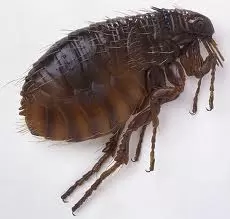
The tough body is able to withstand great pressure, likely an adaptation to survive attempts to eliminate them by mashing or scratching. Even hard squeezing between the fingers is normally insufficient to kill a flea. It is possible to eliminate them by pressing individual fleas with adhesive tape or softened beeswax (or “cheese” wax) or by rolling a flea briskly between the fingers to disable it then crushing it between the fingernails. Fleas also can be drowned in soapy water.
Fleas lay tiny white oval-shaped eggs better viewed through a Loupe. The larva is small, pale, has bristles covering its worm-like body, lacks eyes, and has mouthparts adapted to chewing. The larvae feed on various organic matter, especially the feces of mature fleas. The adult flea’s diet consists solely of fresh blood.In the pupa phase, the larva is enclosed in a silken, debris-covered cocoon.
Fleas go through complete metamorphoses egg,larva, pupa and adult. Adult fleas must feed on blood before they can become capable of reproduction.

The flea life cycle begins when the female lays after feeding. Eggs are laid in batches of up to 20 or so, usually on the host itself. The eggs take around two days to two weeks to hatch (this all varies on conditions)
Flea larvae emerge from the eggs to feed on any available organic material such as dead insects, feces, and vegetable matter. They are blind and avoid sunlight, keeping to dark places like sand, cracks and crevices, and bedding. Given an adequate supply of food, larvae should pupate and weave a silk like cocoon within 1–2 weeks after 3 larval stages. After another week or two, the adult flea is fully developed and ready to emerge from the cocoon. They may however remain resting during this period until they receive a signal that a host is near – vibrations (including sound), heat, and carbon dioxide. Fleas are known to “overwinter” in the larval or pupal stages.
Once the flea reaches adulthood, its primary goal is to find blood and then to reproduce. Adult fleas only have about a week to find food once they emerge ( or they die) but after that they can survive two years to three years between meals. Flea populations are evenly distributed, with about 50% eggs, 35% larvae, 10% pupae, and 5% adults.Their total life span can be as short as one year, but may be several years in ideal conditions. Female fleas can lay 5000 or more eggs over their life, allowing for phenomenal growth rates.
Combatting a flea infestation in the home takes patience because for every flea found on an animal, there could be many more developing in the home. A spot-on insecticide will kill the fleas on the pet and in turn the pet itself will be a roving flea trap and mop up newly hatched fleas. The environment should be treated with a fogger or spray insecticide containing an insect growth regulator, such ad precor, to kill eggs and pupae, which are quite resistant against insecticides. Frequent vacuuming is also helpful, but the vacuum bag must be disposed of immediately afterwards.